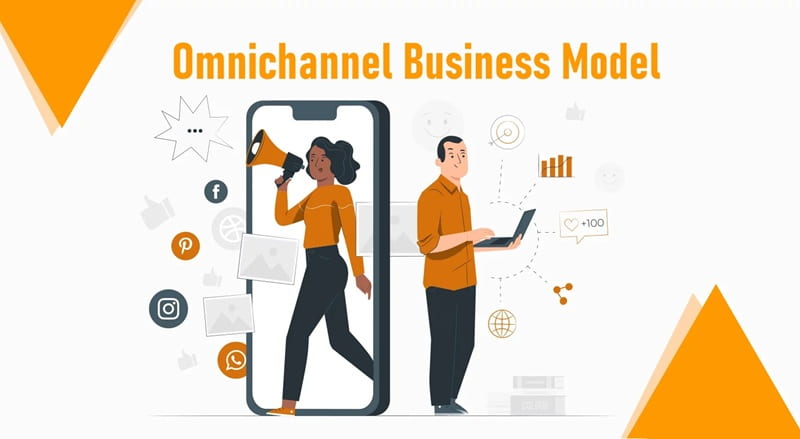Customer expectations are higher than ever, and they want convenience, personalization, and a seamless experience while shopping across multiple touchpoints. To encourage customers to shop, the omnichannel business model is one of the most effective strategies used by several brands these days. This powerful approach makes customers feel a strong connection with the company through customization and fast service.
There are multiple brands around the globe, as well as in India, which use an omnichannel business model so that every lead converts, sales boost, and trust is enhanced. If you are still wondering how the omnichannel business model works, then learning about the definition, examples, and advantages/disadvantages may help.
Omnichannel Business Model: What is it?

An omnichannel business model is a customer-centric strategy where different sales and communication channels are integrated (both online and offline) into one seamless experience. In contrast, a multichannel model is an approach where businesses operate in several channels independently.
In the omnichannel business model, all the sales channels are interconnected to provide a customised and seamless experience. To understand it with an example, you can think of a customer browsing a product on a brand’s website, then the customer adds it to the cart. However, the customer does not buy online but completes the purchase from an offline store. All the customization, changes, and preferences will continue from where the customer closed the website.
Brands offer customer support interaction, loyalty programs, and personalized marketing messages to sync across all channels for a smooth experience. The reduction in friction from one channel to another channel gets resolved with an omnichannel business model.
Key Features of Omnichannel Model
If you are still unsure what an omnichannel model is, there are a few key features that can help you understand it better.
- Channel Integration: All sales and communication platforms are interconnected.
- Customer-Centricity: The focus is on enhancing the customer journey rather than the channel itself.
- Personalization: Businesses use customer data to tailor experiences across different platforms.
- Seamless Transition: Customers can start their journey on one channel and finish it on another without disruption.
- Technology-Driven: Relies on CRM tools, analytics, AI, and data synchronization for smooth operations.
As you can learn from the key features that reduce friction during purchase time, make it easier for a customer to complete the sale.
Examples of Omnichannel Business Model
Many big brands use an omnichannel business model due to its advantages in boosting sales and revenue. However, omnichannel is not a widely preferred approach among all brands. Here are a few top names that use the omnichannel business model:
1. Starbucks
With Starbucks, you can find an omnichannel strategy through their mobile app. Customers get the option to order ahead using their phone and pay online to schedule it. Now the customer can pick up their order from the store. Starbucks promotes the app and offers benefits to customers like loyalty points, which unifies the customer experience.
2. Nike
Athletic wear brand Nike allows customers to browse online and customize the product they want. With the digital customisation from the app, people spend plenty of time. After that, customers can pick the product from physical stores after making sure that they like the product. The seamless integration in play is quite effective.
3. Amazon
In countries like the US and Canada, Amazon has physical stores called Amazon Go and Amazon Fresh Stores. Customers get the option to shop online and order groceries. There are other options, like using Alexa for voice shopping and getting the product from physical stores.
These are some common names, but several brands have started experimenting with an omnichannel business model in the last couple of years.
Advantages of the Omnichannel Business Model
A strategy that solves problems for both the customer and the business has shown a prominent success. Omnichannel strategy offers benefits to customers with their experience, meanwhile, it helps businesses with sales. Below are some core advantages that you can expect from this business model:
1. Enhanced Customer Experience
Customers get a frictionless and consistent journey across different touchpoints. This convenience improves satisfaction and encourages repeat purchases.
2. Stronger Customer Loyalty
When customers feel valued and connected to a brand through personalized interactions, they are more likely to stay loyal. Loyalty programs and app integrations strengthen this bond.
3. Higher Sales and Revenue
Omnichannel strategies encourage customers to spend more. Research shows that customers who shop across multiple channels spend more than those who shop on a single channel.
4. Better Customer Insights
With integrated data from multiple platforms, businesses can analyze customer behavior, preferences, and buying patterns. This helps in designing targeted marketing campaigns.
5. Brand Consistency
The omnichannel model ensures that brand messaging, offers, and experiences remain consistent whether the customer is shopping in-store, online, or through a mobile app.
Disadvantages of the Omnichannel Business Model
Despite being a reliable approach for customers and businesses, the omnichannel business model has a few flaws that make it difficult to implement. In most cases, businesses have to deal with the issues listed below:
1. High Implementation Costs
Integrating systems, upgrading technology, and training staff requires significant investment. Small businesses may find it challenging to adopt fully.
2. Complex Management
Coordinating multiple channels and ensuring seamless synchronization can be difficult. Businesses need advanced tools and strategies to avoid errors.
3. Data Privacy Concerns
Since omnichannel relies heavily on customer data, there is always a risk of breaches or misuse. This requires strict data protection measures.
4. Technology Dependence
The success of omnichannel depends largely on digital tools and platforms. Any technical glitch or downtime can disrupt the customer journey.
5. Consistency Challenges
Ensuring a consistent experience across all touchpoints is easier said than done. Even a minor gap in integration can lead to customer dissatisfaction.
Final Thoughts
The omnichannel business model is more than just a buzzword—it’s a necessity in today’s fast-paced, digital-first world. By providing seamless integration across online and offline channels, businesses can create stronger customer relationships, improve loyalty, and boost sales.



